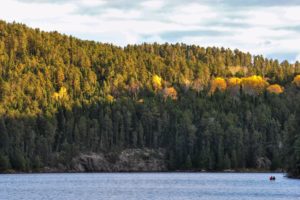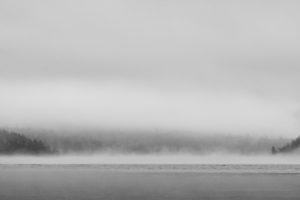 In honor of our founders Charlie & Petra Boostrom and their legacy, we’ll be sharing stories about the Boostroms’ and the early days of Clearwater Historic Lodge and the Gunflint Trail. Many of the stories — including the passage below — come from the delightful book, Gunflint Trailblazers – The Story of Charlie & Petra Boostrom by Beatrice Flaaten Ogren published in 1977.
In honor of our founders Charlie & Petra Boostrom and their legacy, we’ll be sharing stories about the Boostroms’ and the early days of Clearwater Historic Lodge and the Gunflint Trail. Many of the stories — including the passage below — come from the delightful book, Gunflint Trailblazers – The Story of Charlie & Petra Boostrom by Beatrice Flaaten Ogren published in 1977.
********************************
“Charlie’s first winter stretched into a second one — good enough to support a wife. In August he returned to Milaca to marry Petra Mariann Ertsgard. She had been born in Brandt, South Dakota on July 24, 1890 and moved with her family to Milaca in 1903. He brought his bridge to a site on Moon Lake (12 miles west of Clearwater Lake) on the first of September to her first home — a tent.
“Immediately, they started building their first cabin; the newly-weds used a whip saw to saw all the lumber they needed, even enough for a double floor. From Grand Marais, Charlie carried a cook stove, an air-tight heater, windows, 10 rolls of roofing and such sundries as they could not fashion from the forest! Three bushels of beans, 200 pounds of flour and 100 pounds of sugar provided major staple items that first winter.
“Although not finished, on October 1 the cabin was ready for occupancy….Only once during that first winter on Moon Lake did Charlie go into town. He snowshoed the 4o miles starting at daylight, arriving in Grand Marais at 3:30 pm. His pack home weighed 140 to 150 pounds. Visitors to their cabin during their three year stay on Moon Lake were only four in number. Two Indians who had been burned out and were seeking shelter, and Charley Johnson and his wife. Petra did not mind the loneliness however, and kept herself busy while Charlie was on the trap line. In the summer she had a garden, out of which she preserved what she could. Potatoes were kept during the winter by putting them in sacks and sinking them in the lake under the ice to keep them from freezing.
“Petra helped Charlie prepare the stretchers for the fur, tanned hides, made clothing out of the hides and was a helpmate in every possible way. Together they made snowshoes, using ash and birch for the frames and moose hide for thongs. The moose hides had to be scraped first, cleaned of all fur and flesh and soaked in water for a day or two. The hide was then hung in a loop, put over a limb and weighted at the bottom with rocks. It was allowed to dry, then wet again while lacing. Finally the shoe was varnished.
“The tanning of the deer hides for use in the making of mittens, moccasins, and jackets was a laborious process — one they had learned from the Indians. First the hide was scraped clean and soaked in water with the brains of the animal for four days. It was then wrung out by putting it around a stump and working it like a tourniquet. It was worked dry by stretching it with the hands. The moose hides were tougher and more difficult to make pliable. These had to be sewn in a frame and worked dry with a paddle — a process which took about ten hours. Moose hide made the best moccasins for use on the trail, worn with two pairs of wool socks under them. They made all their own moccasins after discovering that the purchased ones from Canada, which had been commercially tanned and oiled, were too slippery.”


